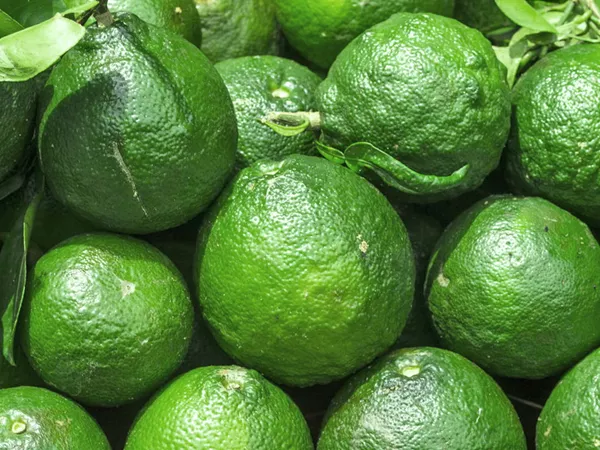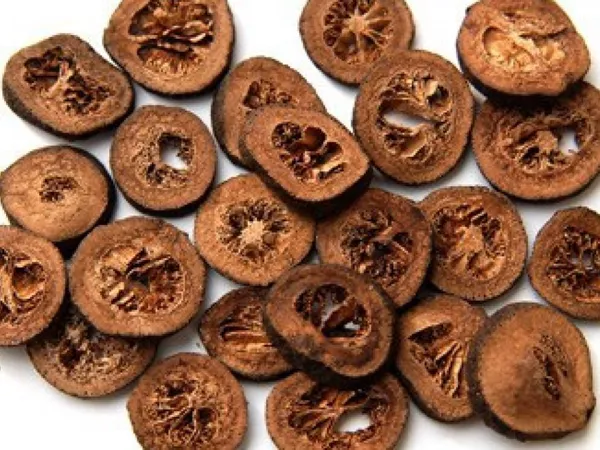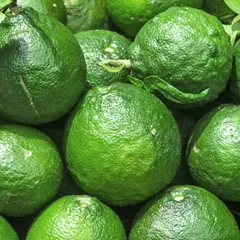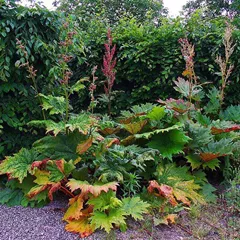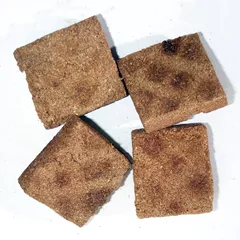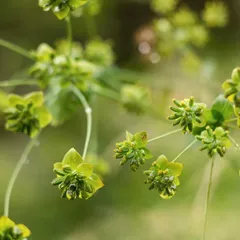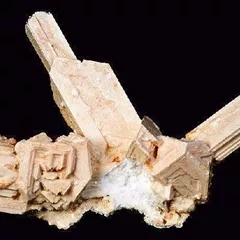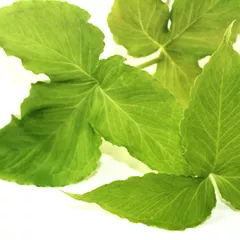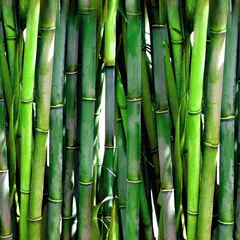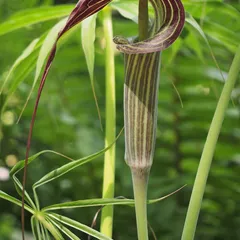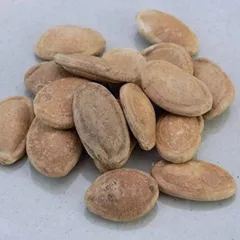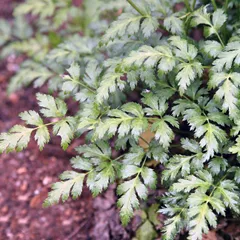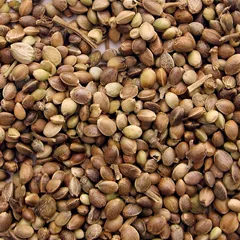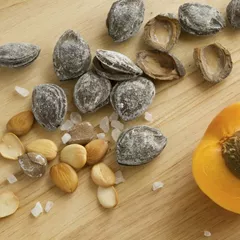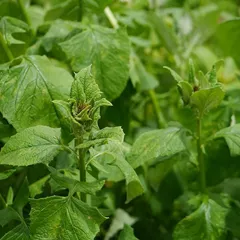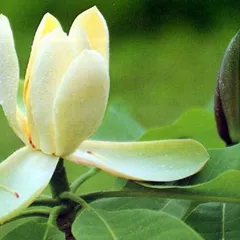Zhi Shi
Zhi Shi
English: Immature Bitter Oranges
Chinese: 枳实
Parts used: Dried unripe fruit
TCM category: Herbs that regulate Qi
TCM nature: Cool
TCM taste(s): BitterPungentSour
Organ affinity: Spleen Stomach Large intestine
Scientific name: Citrus aurantium
Other names: Fructus Aurantii Immaturus
Use of Zhi Shi (immature bitter oranges) in TCM
Please note that you should never self-prescribe TCM ingredients. A TCM ingredient is almost never eaten on its own but as part of a formula containing several ingredients that act together. Please consult a professional TCM practitioner, they will be best able to guide you.
Preparation: Pick the fruit when unripe. Dry it and cut in slices
Dosage: 3 - 9 grams
Main actions according to TCM*: Regulates the flow of Qi in the Middle Burner and reduces Food Stagnation. Moves Qi downward and helps constipation. Reduces Stagnant Phlegm and lessens distention and pain. For prolapse of organs when used with the appropriate herbs.
Primary conditions or symptoms for which Zhi Shi may be prescribed by TCM doctors*: Indigestion Abdominal bloating Constipation Chest pain Chest congestion Rectal prolapse Uterine prolapse
Contraindications*: This herb should be used with caution during pregnancy, when there is Q! Deficiency or when there is Cold in the Stomach.
Common TCM formulas in which Zhi Shi is used*
Zhi Shi Dao Zhi Wan
Source date: 1247 AD
Number of ingredients: 8 herbs
Formula key actions: Reduces and guides out stagnation and accumulation. Drains heat. Dispels dampness.
Zhi Shi is a king ingredient in Zhi Shi Dao Zhi Wan. Like the name indicates, it means it has more power than other ingredients in the formula.
In Zhi Shi Dao Zhi Wan, Zhi Shi breaks up stagnant Qi and reduce accumulation
Si Ni San
Source date: 220 AD
Number of ingredients: 4 herbs
Formula key actions: Regulates Liver and Spleen. Eliminates Internal Heat.
Conditions targeted*: CholecystitisCholelithiasis and others
Zhi Shi is a deputy ingredient in Si Ni San. This means it helps the king ingredient(s) treat the main pattern or it serves to treat a coexisting pattern.
In Si Ni San, Zhi Shi drains Stagnation, breaks up Stagnant Qi, and reduces accumulation in the Middle Burner to facilitate the transportive and transformative functions of the Spleen and Stomach.
Its descending action pairs it well with the ascending action of Chai Hu (the key herb): the effect of the different directions is to disentangle Heat in the Liver, Stomach and Spleen territories.
Da Chai Hu Tang
Source date: 220 AD
Number of ingredients: 8 herbs
Formula key actions: Harmonizes and releases the Lesser Yang. Drains internal clumping due to Heat.
Conditions targeted*: CholecystitisCholelithiasis and others
Zhi Shi is a deputy ingredient in Da Chai Hu Tang. This means it helps the king ingredient(s) treat the main pattern or it serves to treat a coexisting pattern.
In Da Chai Hu Tang, Zhi Shi strongly invigorates Qi so as to remove Qi Stagnation. It helps to reduce focal distention and fullness in the chest and abdomen.
Together with the key herb Bupleurum, it strengthens Qi circulation. When combined with Rhubarb, it breaks up
clumping in the bowels.
Huang Long Tang
Source date: 1445 AD
Number of ingredients: 10 herbs
Formula key actions: Clear Heat from the Interior . Supports the Original Qi.
Conditions targeted*: TyphoidParatyphoid and others
Zhi Shi is a deputy ingredient in Huang Long Tang. This means it helps the king ingredient(s) treat the main pattern or it serves to treat a coexisting pattern.
In Huang Long Tang, Zhi Shi reduces fullness and distention.
Wen Dan Tang
Source date: 1174 AD
Number of ingredients: 8 herbs
Formula key actions: Clears Phlegm. Clears Gallbladder. Regulates Qi. Harmonizes the Stomach.
Conditions targeted*: HypertensionAngina and others
Zhi Shi is an assistant ingredient in Wen Dan Tang. This means that it either serves to reinforces the effect of other ingredients or it moderates their toxicity.
In Wen Dan Tang, Zhi Shi reverses the flow of Rebellious Qi and is particularly effective in treating focal distention.
Da Cheng Qi Tang
Source date: 220 AD
Number of ingredients: 4 herbs
Formula key actions: Purges Heat from the Stomach and Intestines. Relieves constipation.
Conditions targeted*: PancreatisAppendicitis and others
Zhi Shi is an assistant ingredient in Da Cheng Qi Tang. This means that it either serves to reinforces the effect of other ingredients or it moderates their toxicity.
In Da Cheng Qi Tang, Zhi Shi dissipates clumps and reduces focal distention.
Qing Qi Hua Tan Wan
Source date: 1584 AD
Number of ingredients: 8 herbs
Formula key actions: Clears Heat. Transforms Phlegm. Directs Rebellious Qi downwards. Stops coughing.
Conditions targeted*: PneumoniaChronic bronchitis and others
Zhi Shi is an assistant ingredient in Qing Qi Hua Tan Wan. This means that it either serves to reinforces the effect of other ingredients or it moderates their toxicity.
In Qing Qi Hua Tan Wan, Zhi Shi work together with Tangerine peel (Chen Pi), another assistant herb here, to regulate the Qi, dispelling the focal distention and dissipating the clumps of Phlegm.
Huang Lian Wen Dan Tang
Source date: 1852 AD
Number of ingredients: 7 herbs
Formula key actions: Clears Hot Phlegm. Clears Gallbladder Heat. Regulates Qi. Harmonizes the Stomach.
Conditions targeted*: HypertensionAngina and others
Zhi Shi is an assistant ingredient in Huang Lian Wen Dan Tang. This means that it either serves to reinforces the effect of other ingredients or it moderates their toxicity.
In Huang Lian Wen Dan Tang, Zhi Shi reverses the flow of Rebellious Qi and is particularly effective in treating focal distention.
Ma Zi Ren Wan
Source date: 220 AD
Number of ingredients: 7 herbs
Formula key actions: Moistens the Intestines. Invigorates Qi. Unblocks the bowels. Drains Heat.
Conditions targeted*: Incomplete intestinal obstructionPostoperative ileus and others
Zhi Shi is an assistant ingredient in Ma Zi Ren Wan. This means that it either serves to reinforces the effect of other ingredients or it moderates their toxicity.
In Ma Zi Ren Wan, Zhi Shi breaks up accumulation, particularly in the Intestines.
Xiang Sha Yang Wei Wan
Source date: 1587 AD
Number of ingredients: 13 herbs
Formula key actions: Strengthens and harmonizes the Spleen and Stomach. Resolves Dampness.
Conditions targeted*: Poor appetiteLoss of taste and others
In Xiang Sha Yang Wei Wan, Zhi Shi regulates the flow of Qi in the Middle Burner and reduces Food Stagnation.
Xiao Cheng Qi Tang
Source date: 220 AD
Number of ingredients: 3 herbs
Formula key actions: Moderately purges Heat accumulation. Circulates Qi in the Middle .
Conditions targeted*: Acute cholecystitisAcute pancreatitis and others
In Xiao Cheng Qi Tang, Zhi Shi spreads and descends Qi, dries Dampness, transforms Phlegm and relieves fullness.
Key TCM concepts behind Zhi Shi's properties
In Traditional Chinese Medicine (TCM), Zhi Shi belongs to the 'Herbs that regulate Qi' category. Herbs in this category typically treat a TCM condition called 'Qi Stagnation'. Concretely it means that Qi is blocked in the body's Organs and Meridians, most typically the Stomach, Liver, and to a lesser extent, the Lungs. In modern medicine terms, Qi Stagnation often translates into psychological consequences such as depression, irritability or mood swings. It's also frequently associated with conditions such as premenstrual syndrome (PMS), menopausal symptoms, the development of breast swellings as well as various digestive disorders.
Furthermore Zhi Shi is Cool in nature. This means that Zhi Shi tends to help people who have too much 'Heat' in their body, although with less effect than a plant that would be Cold in nature. Balance between Yin and Yang is a key health concept in TCM. Those who have too much Heat in their body are said to either have a Yang Excess (because Yang is Hot in nature) or a Yin deficiency (Yin is Cold in Nature). Depending on your condition Zhi Shi can help restore a harmonious balance between Yin and Yang.
Zhi Shi also tastes Bitter, Pungent and Sour. The so-called 'Five Phases' theory in Chinese Medicine states that the taste of TCM ingredients is a key determinant of their action in the body. Bitter ingredients like Zhi Shi tends to have a cleansing action on the body by clearing Heat, drying Dampness and promoting elimination via urination or bowel movements. On the other hand Pungent ingredients tend to promote the circulations of Qi and Body Fluids. That's why for instance someone tends to sweat a lot when they eat spicy/pungent food. Lastly Sour ingredients help with digestion and restrain abnormal discharges of Fluids from the body, such as diarrhea or heavy sweating.
The tastes of ingredients in TCM also determine what Organs and Meridians they target. As such Zhi Shi is thought to target the Spleen, the Stomach and the Large intestine. In TCM the Spleen assists with digestion, Blood coagulation and Fluids metabolism in the body. The Stomach on the other hand is responsible for receiving and ripening ingested food and fluids. It is also tasked with descending the digested elements downwards to the Small Intestine. The Large Intestine receives the "impure" parts of the digested food from the Small Intestine, absorbs the remaining fluids and excrete the remainder as feces.

